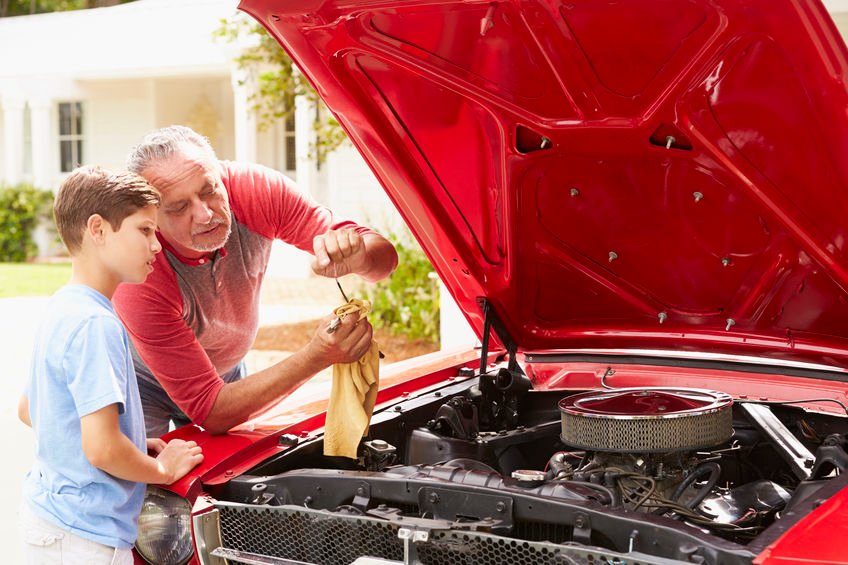Essential Tips & Tricks for Maintaining Vintage Cars
Vintage cars are a cherished piece of automotive history. Their classic designs and timeless elegance make them a favorite among car enthusiasts. However, maintaining a vintage car requires specialized knowledge and care to ensure it remains in pristine condition. In this article, we will explore essential tips and tricks for effective vintage car maintenance, ensuring your classic ride continues to turn heads and drive smoothly for years to come.

Understanding Vintage Car Maintenance
1. Regular Cleaning and Detailing Maintaining the aesthetic appeal of your vintage car starts with regular cleaning and detailing. Dust, dirt, and grime can accumulate over time, causing damage to the paint and interior. Use gentle, non-abrasive cleaning products specifically designed for vintage cars. Pay attention to details such as chrome fixtures, leather seats, and wooden dashboards.
2. Proper Storage One of the most critical aspects of vintage car maintenance is proper storage. Vintage cars should be stored in a clean, dry, and climate-controlled environment to prevent rust, corrosion, and other weather-related damage. Investing in a high-quality car cover can also provide additional protection.
3. Regular Oil Changes Frequent oil changes are vital for keeping your vintage car’s engine in top condition. Use high-quality motor oil suitable for older engines, as modern oils may not provide the necessary protection. Regular oil changes help prevent engine wear and tear, ensuring smooth and efficient operation.
4. Tire Care Vintage cars often come with unique tire specifications. Regularly check tire pressure and inspect for signs of wear and tear. Rotating the tires periodically can help ensure even wear. If your vintage car has been in storage for an extended period, it’s essential to inspect the tires for flat spots and replace them if necessary.
5. Brake System Maintenance The brake system is a crucial component of vintage car maintenance. Regularly check the brake fluid levels and inspect the brake pads, rotors, and lines for wear. Vintage cars may have drum brakes, which require different maintenance procedures compared to modern disc brakes. Ensuring the brake system is in good condition is vital for safe driving.
6. Battery Maintenance Vintage cars often have electrical systems that differ from modern vehicles. Regularly check the battery for corrosion and ensure it is charged. Using a trickle charger can help maintain the battery’s charge during periods of inactivity. Replace the battery as needed to avoid starting issues.
7. Cooling System Care The cooling system in vintage cars is essential for preventing engine overheating. Regularly check the coolant levels and inspect the radiator, hoses, and water pump for leaks or damage. Flushing and refilling the cooling system periodically can help prevent corrosion and maintain optimal performance.
8. Fuel System Maintenance Vintage cars may have carburetors instead of modern fuel injection systems. Regularly inspect the fuel lines, filter, and carburetor for signs of wear or clogging. Using a fuel stabilizer can help prevent the fuel from deteriorating during periods of storage.
Specialized Vintage Car Maintenance Tips
1. Preservation of Original Parts One of the hallmarks of vintage car ownership is the preservation of original parts. Whenever possible, opt for repairs and replacements that maintain the car’s originality. Authentic parts not only preserve the car’s value but also its historical integrity.
2. Professional Inspections While regular DIY maintenance is essential, professional inspections are equally important. Vintage cars may have hidden issues that require the expertise of a qualified mechanic. Regular professional inspections can help identify and address potential problems before they become major issues.
3. Documentation and Record Keeping Keeping detailed records of your vintage car’s maintenance history is crucial. Documenting repairs, replacements, and routine maintenance helps track the car’s condition and provides valuable information for future owners. Organized records also enhance the car’s value and authenticity.
4. Joining Vintage Car Clubs Becoming a member of a vintage car club can provide access to valuable resources and a network of fellow enthusiasts. These clubs often organize events, workshops, and swap meets where you can learn more about vintage car maintenance and find rare parts.
5. Understanding Your Car’s Specific Needs Every vintage car is unique, and understanding its specific needs is essential for effective maintenance. Consult the car’s manual and seek advice from experts familiar with the make and model of your vehicle. Tailoring your maintenance routine to your car’s requirements ensures optimal performance and longevity.
DIY Vintage Car Maintenance Tips
1. Fluid Checks and Top-Ups Regularly check all fluid levels, including oil, coolant, brake fluid, and transmission fluid. Top up as necessary and look for any signs of leaks. Keeping fluids at optimal levels ensures smooth operation and prevents potential damage.
2. Inspection of Belts and Hoses Inspect all belts and hoses for signs of wear, cracks, or leaks. Replace any damaged components promptly to avoid breakdowns. Belts and hoses play a crucial role in the functioning of various systems within your vintage car.
3. Spark Plug Replacement Spark plugs are essential for engine performance. Regularly inspect and replace spark plugs to ensure efficient combustion. Using the correct type of spark plug for your vintage car is vital for optimal performance.
4. Lubrication of Moving Parts Regularly lubricate moving parts such as door hinges, throttle linkages, and suspension components. Proper lubrication reduces friction and wear, ensuring smooth operation and preventing premature failure.
5. Checking and Replacing Filters Inspect and replace air, fuel, and oil filters regularly. Clean filters improve engine performance and fuel efficiency. Using high-quality filters designed for vintage cars ensures optimal filtration and protection.
Common Vintage Car Maintenance Challenges
1. Availability of Parts Finding original or high-quality replacement parts for vintage cars can be challenging. Join vintage car clubs, attend swap meets, and explore online marketplaces to source rare parts. Building a network of contacts in the vintage car community can also help in locating hard-to-find components.
2. Specialized Knowledge Maintaining a vintage car requires specialized knowledge and skills. Educate yourself about your car’s specific needs and consult with experts when necessary. Investing time in learning about vintage car maintenance pays off in the long run.
3. Preventing Rust and Corrosion Vintage cars are susceptible to rust and corrosion, especially if not stored properly. Regularly inspect the car’s body and undercarriage for signs of rust. Applying rust inhibitors and maintaining a clean, dry storage environment can help prevent rust-related damage.
4. Balancing Originality and Modernization Striking a balance between preserving the car’s originality and incorporating modern upgrades can be challenging. Carefully consider any modifications and seek advice from experts to ensure they enhance the car’s performance without compromising its historical value.
Conclusion
Maintaining a vintage car is a labor of love that requires dedication, knowledge, and attention to detail. By following these essential tips and tricks for vintage car maintenance, you can ensure your classic ride remains in pristine condition and continues to be a source of pride and joy. Regular cleaning, proper storage, and attention to critical systems such as the engine, brakes, and cooling system are key to preserving the beauty and functionality of your vintage car. Embrace the unique challenges and rewards of vintage car ownership, and enjoy the timeless elegance and driving experience that only a classic car can provide.


You must be logged in to post a comment.